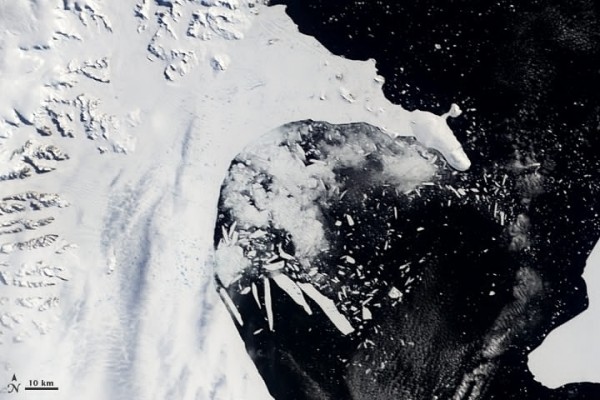Antarctica Risks Catastrophic Ice Shelf Collapse: Thinning from Above and Below Ice
| Ana Verayo | | May 13, 2015 09:44 AM EDT |
(Photo : NASA Earth Observatory) The collapse of the Larsen B Ice Shelf was captured in this series of images from the Moderate Resolution Imaging Spectroradiometer (MODIS) on NASA’s Terra satellite between January 31 and April 13, 2002.
The Antarctic Peninsula apparently just lost two massive ice shelves in the last 20 years, which are the Larsen A and Larsen B where each massive floating ice disappeared in a span of a few weeks.
This new study explores why these ice shelves collapsed and also confirmed that the Larsen C ice shelf is also melting not just from the warming air since the Antarctica Peninsula is also one of the most susceptible regions to warming but also due to the warming occurring in the ocean.
Like Us on Facebook
According to lead author of the study and climate scientist Paul Holland of the British Antarctic Survey, there's a strong atmospheric warming in the region and this summer has set new heat records however, nobody knew that the ocean apparently is a big factor in the collapse of the ice shelves.
The ice shelf known as Larsen C is estimated to be the size of West Vriginia which is a flat massive plain of floating ice that is generated by the flowing glaciers originating from the Antarctic Peninusla. It is also the largest ice shelf in the region.
Researchers have monitored the changes in thickness across the ice shelf between 1998 and 2012 using satellites and ground based radars where scientists observed that Larsen C lost thickness in two methods during this span of time.
The first method happens when air escapes from the old snow layer from the top layer of the ice. This old snow is called firn where it has tiny permeating air pockets that aids in insulation for the ice underneath.
During summer, meltwater can seep through the snow and this causes the firn to lose thickness as it melts down, releasing the trapped air. When the firn freezes into ice again, meltwater that formed ponds on the surface absorbs more sunlight and heat that aggravates further melting.
Holland believes that Larsen B ice shelf lost all the air from its firn layer just before its major collapse in 2002.
The second method involves Larsen C that is continuously melting from below. The study revealed that the ice shelf surface lost an average of three feet. Ground based radar data revealed how much air is still in the firn where the scientists determined that the ice shelf thinned an average of 13 feet from 1998 to 2012.
Holland adds that Larsen C is sinking lower in the water due to this ice loss.This is the first time that melting below the ice can be pinned down to the Antartic's vanishing ice shelves as warming ocean waters are slowly eating away at the ice shelves in West Antarctica even if heat from the atmosphere remains the major culprit.
Scientists believe that Larsen C will have a few more decades before it becomes close to cracking where a crack is already forming near the northern edge of the shelf.
This study is published in the journal The Cryosphere.
©2015 Chinatopix All rights reserved. Do not reproduce without permission
EDITOR'S PICKS
-

Did the Trump administration just announce plans for a trade war with ‘hostile’ China and Russia?
-

US Senate passes Taiwan travel bill slammed by China
-

As Yan Sihong’s family grieves, here are other Chinese students who went missing abroad. Some have never been found
-

Beijing blasts Western critics who ‘smear China’ with the term sharp power
-

China Envoy Seeks to Defuse Tensions With U.S. as a Trade War Brews
-

Singapore's Deputy PM Provides Bitcoin Vote of Confidence Amid China's Blanket Bans
-

China warns investors over risks in overseas virtual currency trading
-

Chinese government most trustworthy: survey
-

Kashima Antlers On Course For Back-To-Back Titles
MOST POPULAR
LATEST NEWS
Zhou Yongkang: China's Former Security Chief Sentenced to Life in Prison

China's former Chief of the Ministry of Public Security, Zhou Yongkang, has been given a life sentence after he was found guilty of abusing his office, bribery and deliberately ... Full Article
TRENDING STORY

China Pork Prices Expected to Stabilize As The Supplies Recover

Elephone P9000 Smartphone is now on Sale on Amazon India

There's a Big Chance Cliffhangers Won't Still Be Resolved When Grey's Anatomy Season 13 Returns

Supreme Court Ruled on Samsung vs Apple Dispute for Patent Infringement

Microsoft Surface Pro 5 Rumors and Release Date: What is the Latest?










